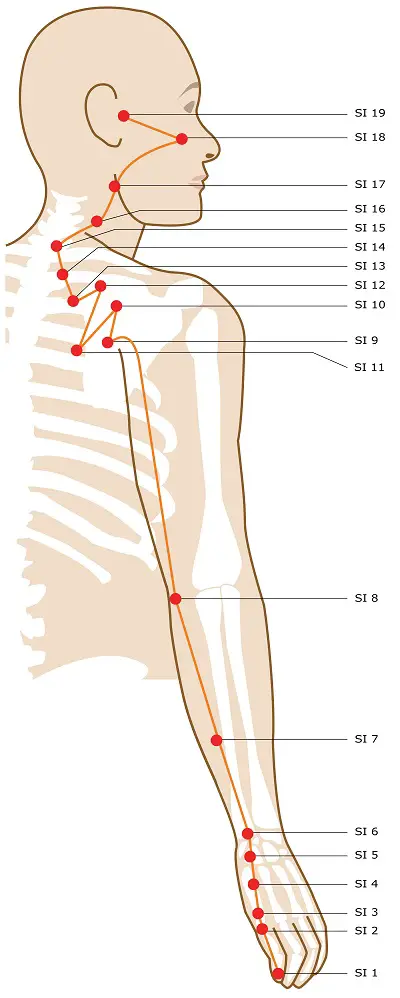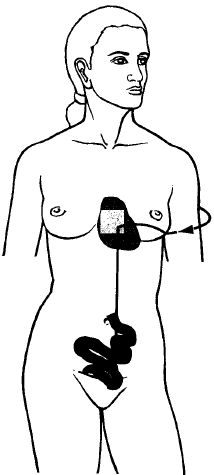Small Intestine Meridian Acupuncture Points

Small Intestine Meridian Points
- SI 1: shao ze / Lesser March
- Function: Expels wind-heat, subdues wind, opens the orifices, removes obstructions from the channel, promotes lactation.
- Indications: Headache, febrile diseases, loss of consciousness, redness of the eye, cloudiness of the cornea.
- SI 2: qian gu / Front Valley
- Function: Clears heat.
- Indications: Numbness of the fingers, febrile diseases, tinnitus, headache, reddish urine.
- SI 3: hou xi / Back Ravine
- Function: Eliminates interior wind from the Governing Vessel, expels exterior wind, benefits sinews, resolves dampness and jaundice, clears the mind.
- Indications: Pain and rigidity of the neck, tinnitus, deafness, sore throat, mania, malaria, acute lumbar sprain, night sweating, febrile diseases, contracture and numbness of the fingers, pain in the shoulder and elbow.
- SI 4: wan gu / Wrist Bone
- Function: Removes obstructions from the channel, eliminates damp-heat.
- Indications: Febrile diseases with anhidrosis, headache, rigidity of the neck, contracture of the fingers, pain in the wrist, jaundice.
- SI 5: yang gu / Yang Valley
- Function: Clears mind, removes obstructions from the channel, expels exterior damp-heat.
- Indications: Swelling of the neck and submandibular region, pain of the hand and wrist, febrile diseases.
- SI 6: yang lao / Nursing the Aged
- Function: Benefits the sinews, brightens the eyes, removes obstructions from the channel.
- Indications: Blurring of vision, pain in the shoulder, elbow and arm.
- SI 7: zhi zheng / Branch to the Correct
- Function: Removes obstructions from the channel, calms the mind.
- Indications: Neck rigidity, headache, dizziness, spasmodic pain in the elbow and fingers, febrile diseases, mania.
- SI 8: xiao hai / Small Sea
- Function: Resolves damp-heat, removes obstructions from the channel, calms the mind.
- Indications: Headache, swelling of cheek, pain in nape, shoulder, arm and elbow, epilepsy.
- SI 9: jian zhen / True Shoulder
- Function: Courses wind and quickens the connecting vessels, dissipates, binds and relieves pain.
- Indications: Pain in the scapular region, motor impairment of the hand and arm.
- SI 10: nao shu / Upper Arm Point
- Function: Quickens the blood and frees the connecting vessels, soothes the sinews and dissipates binds.
- Indications: Swelling of the shoulder, aching and weakness of the shoulder and arm.
- SI 11: tian zong / Celestial Gathering
- Function: Resolves Tai Yang channel pathogens, diffuses Qi stagnation in the chest and lateral costal region.
- Indications: Pain in the scapular region, pain in the lateroposterior aspect of the elbow and arm, asthma.
- SI 12: bing feng / Grasping the Wind
- Function: Frees the channels and quickens the connecting vessels.
- Indications: Pain in the scapular region, numbness and aching of the upper extremities, motor impairment of the shoulder and arm.
- SI 13: qu yuan / Crooked Wall
- Function: Soothes the sinews and quickens the blood.
- Indications: Pain and stiffness of the scapular region.
- SI 14: jian wai shu / Outer Shoulder Transporter
- Function: Courses wind and quickens the connecting vessels, warms the channels and dissipates cold.
- Indications: Aching of the shoulder and back, pain and rigidity of the neck.
- SI 15: jian zhong shu / Central Shoulder Transporter
- Function: Diffuses the lung and clears heat, transforms phlegm and brightens the eyes.
- Indications: Cough, asthma, pain in the shoulder and back, hemoptysis.
- SI 16: tian chuang / Celestial Window
- Function: Dispels wind and quickens the connecting vessels, quiets the spirit and nourishes the Heart.
- Indications: Sore throat, sudden loss of voice, deafness, tinnitus, stiffness and pain of the neck.
- SI 17: tian rong / Celestial Countenance
- Function: Resolves damp-heat, expels fire-poison, removes obstructions from the channel.
- Indications: Deafness, tinnitus, sore throat, swelling of the cheek, foreign body sensation in the throat, goiter.
- SI 18: quan liao / Cheek Bone-Hole
- Function: Expels wind, relieves pain.
- Indications: Facial paralysis, twitching of eyelids, pain in the face, toothache, swelling of the cheek, yellowish sclera.
- SI 19: ting gong / Auditory Palace
- Function: Benefits the ears.
- Indications: Deafness, tinnitus, otorrhea, motor impairment of the mandibular joint, toothache.
Common Uses
- Reducing fever related to Small Intestine meridian energy disruption, especially fever caused by malaria.
- Clearing phlegm.
- Treating mania.
- Alleviating pain along the Small Intestine meridian, including in the arm, axilla, shoulder, scapula, neck and throat, jaw, mouth, teeth, tongue, nose, cheek, eyes, and ears, which are all affected by this meridian.
- Reducing swelling, especially in the neck, throat, and cheeks.
- Treating breast disorders, and disorders on the side of the breast (lateral costal region).
Small Intestine Meridian Channels & Sinews
Along with its primary energy pathway, the Small Intestine meridian also has secondary branches of energy that spread out and influence other parts of the body.
It also has a muscle/tissue zone called the sinews which it strongly influences as well.
Let’s take a look at these secondary characteristics of this meridian.

Source: A Manual of Acupuncture
First up we have the Small Intestine luo-connecting channel, which is located on the arm alongside the primary meridian.
This secondary energy channel begins at the acupoint SI7, and then climbs the arm until it reaches its end on the side of the shoulder area.
At its upper end point, this channel connects with acupoint LI15 of the Large Intestine Meridian.

Source: A Manual of Acupuncture
Next we have the Small Intestine divergent channel.
This energy pathway separates from the primary meridian on the shoulder, near acupoint SI9.
The pathway enters the chest area and passes through the physical heart, then goes downwards into the physical small intestines where it ends.

Source: A Manual of Acupuncture
Lastly, we have the Small Intestine sinew channel.
This area of tissues that is strongly affected by the Small Intestine meridian begins on the little finger where the meridian itself begins at acupoint SI1.
It travels up the arm in the same area as the primary meridian, attaching to the joints at the wrist, elbow, and shoulder area.
It covers a large portion of the back shoulder blade area, then continues up the neck and onto the side of the head where it follows the pathway on the face of the primary meridian channel.
A small sub-branch of the sinew channel separates from the main sinew channel behind the ear, and goes into the ear.
Finally, the sinew channel ends on the side of the head near the top, very close to the acupoint ST8 of the Stomach Meridian.
Related Pages
The 12 Primary Meridians
- Heart
- Pericardium
- Lung
- Spleen
- Liver
- Kidney
- Small Intestine
- Large Intestine
- Triple Energizer
- Stomach
- Gallbladder
- Bladder